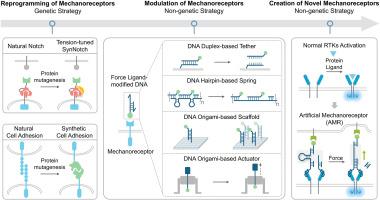Synthetic mechanoreceptor engineering: From genetic encoding to DNA nanotechnology-based reprogramming
引用次数: 0
Abstract
Precise modulation of mechanoreceptor-mediated signal transduction is crucial for decoding cellular mechanotransduction mechanisms and programming cell fate. This review provides a comprehensive summary of recent advances in engineering synthetic mechanoreceptors, spanning from protein-centric genetic encoding to DNA nanotechnology-based non-genetic reprogramming strategies. Genetic engineering strategies employ protein structure encoding and site-directed mutagenesis to reprogram force-response functions in natural mechanoreceptors. As a complementary non-genetic approach, DNA nanotechnology leverages its programmability, modularity, and predictable mechanical properties to achieve precise control over receptor functionalities. The flourishing development of DNA mechanosensitive nanodevices has provided a promising synthetic toolkit for manipulating mechanoreceptors, enabling precise control over receptor spatial organization and signal transduction. A key innovation is the development of novel DNA-functionalized artificial mechanoreceptors (AMRs), which confer force-responsiveness to naturally non-mechanosensitive receptors without genetic modification, thereby enabling customized mechanotransduction and mechanobiological applications. Collectively, this paradigm shift highlights DNA-based non-genetic receptor engineering as a versatile and powerful toolkit, paving new avenues for mechanobiology research and pioneering force-directed therapeutic strategies in regenerative medicine.

合成机械受体工程:从遗传编码到基于DNA纳米技术的重编程
机械受体介导的信号转导的精确调节对于解码细胞机械转导机制和编程细胞命运至关重要。本文综述了工程合成机械感受器的最新进展,从以蛋白质为中心的遗传编码到基于DNA纳米技术的非遗传重编程策略。基因工程策略采用蛋白质结构编码和定点诱变来重编程自然机械感受器的力响应功能。作为一种互补的非遗传方法,DNA纳米技术利用其可编程性、模块化和可预测的机械特性来实现对受体功能的精确控制。DNA机械敏感纳米器件的蓬勃发展为操纵机械感受器提供了一个有前途的合成工具包,使精确控制受体的空间组织和信号转导成为可能。一项关键的创新是新型dna功能化人工机械感受器(AMRs)的发展,它在没有基因修饰的情况下赋予自然非机械敏感感受器力响应性,从而实现定制的机械转导和机械生物学应用。总的来说,这种范式转变突出了基于dna的非遗传受体工程作为一个多功能和强大的工具箱,为机械生物学研究和再生医学中先锋力导向治疗策略铺平了新的道路。
本文章由计算机程序翻译,如有差异,请以英文原文为准。
求助全文
约1分钟内获得全文
求助全文

 求助内容:
求助内容: 应助结果提醒方式:
应助结果提醒方式:


